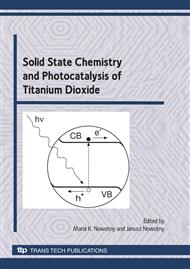p.135
p.163
p.179
p.203
p.221
p.239
p.261
p.295
p.329
An Overview of Semi-Conductor Photocatalysis: Modification of TiO2 Nanomaterials
Abstract:
Since the beginning of life on earth, the environment has been polluted by waste, both natural as well as synthetic (man-made). In the case of natural waste however, the environment by itself controls the effect of contamination. But in the case of synthetic materials, the pollution is higher even in trace concentration and this may go on accumulating, leading to disastrous effects on the environment and ecology. Industrial wastes containing heavy metals and pesticide residues fall in this category. The major point sources of pesticide pollution are wastewater from agricultural industries and pesticide manufacturing and formulating plants. Hence the waste from these sources must be removed or destroyed before discharge to the environment. There have been several methods practiced for the treatment of wastewater. However many of them are not able to achieve hundred percent satisfaction. Environmental pollution and destruction on a global scale as well as lack of sufficient clean and natural energy sources have drawn much attention and concern to the vital need for ecologically clean chemical technology, materials and processes. This is one of the most urgent challenges facing chemical scientists. Recently, light-induced photocatalytic reactions have gained a lot of attention for the purification of wastewater.
Info:
Periodical:
Pages:
239-260
Citation:
Online since:
June 2010
Authors:
Price:
Сopyright:
© 2010 Trans Tech Publications Ltd. All Rights Reserved
Share:
Citation:


